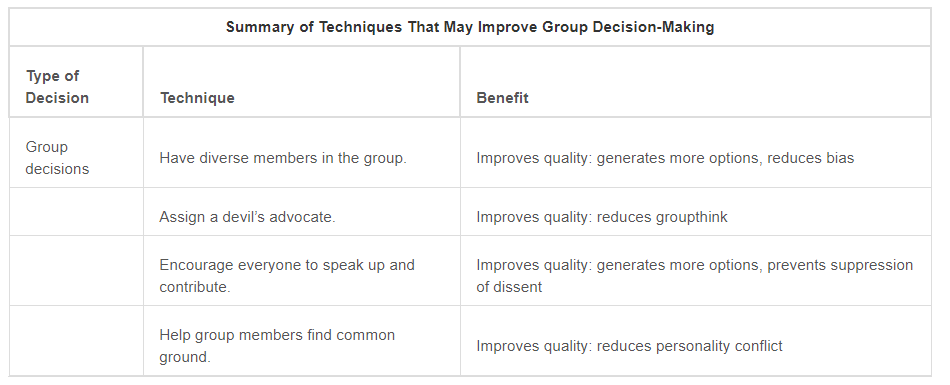8.4 Group Decision Making
Within group decision-making, decisions not only affect the individual, but affect each member of the group. Decision-making is the method or action of thinking through a process and coming to a consensus. Therefore, group decision-making is the coming to a consensus with multiple individuals in a collaborative nature. Within learning organizations, the notion of collaboration can be beneficial to the advancement of learning within it. There are some common advantages and disadvantages to group decision-making within organizations.
| Advantages | Disadvantages |
|---|---|
|
•involving numerous people with different ideas
•reduce bias in making informed decisions
•effective consensus can lead to a superior outcome
|
•conflict can hinder process
•an individual with more power exerts more influence on the group
•more power leads to other members not sharing ideas
|
Advantages and disadvantages present two different types of representations within a group dynamic. The main advantage is that individuals within a group have a voice, leading to the process of brainstorming, which is the generating of a variety of solutions or possible outcomes for an effective decision[6]. On the other hand, the main disadvantage is regarded as group-think, which occurs when one person uses her or his power in a group process and individuals will remain silent, not to disturb the peace (i.e. going along with the flow)[6]. Regardless of brainstorming or group-think, members within a group must be held accountable for the decisions that they make. This is enhanced through more inclusion, as the more individuals are included, the responsibility and accountability is distributed equally, as opposed to an individual who makes the decision on behalf of the group. One individual makes the decision, but the accountability is still distributed equally, therefore the positive or negative outcome of the decision falls on someone who had no part in the decision-making process.
One way to develop a quality group, especially if there is a clear power dynamic present, is to add a contrarian, or a member to play devil’s advocate. A member who plays devil’s advocate reduces group-think[6], and provides an alternate view or a challenge to an individual’s logic on a decision. For example, in a university meeting with professors and department heads, it may be beneficial to have a student present to offer a differing view that is contrary to the views of professors or administrators. If administrators are making decisions about students within an institution, a student who offers a contrarian view may avoid administrative group-think, and have senior members see their decision from the perspective of a student.
Group decisions are more effective when time is available for group involvement and when the problem is unclear. If there is time available, and it is necessary to tackle a difficult problem, here is a summary of some different techniques that improve group decision-making[6].

Within a learning organization, groups are able to share ideas and their own learning experiences that improve the quality of the learning for all members within the group. Chapter Nine we will probe in depth into collaboration within a learning organizations, and the implications it has on learning styles within a modern learning environment.
Review Questions:
- What is bounded rationality? How do we manage it?
- What is confirmation bias? How do we avoid it?
- Why is it important to have a contrarian or devil’s advocate in the group decision-making process?
The generating of a variety of solutions or possible outcomes for an effective decision
When one person uses their power in a group process and individuals will remain silent not to disturb the peace (i.e. going along with what the individual thinks as a group)
Provides an alternate view or a challenge to an individual’s logic on a decision

